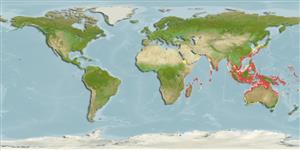Environment: milieu / climate zone / depth range / distribution range
Ökologie
seewasser riff-verbunden; tiefenbereich 35 - 50 m (Ref. 9806). Tropical
Indo-West Pacific: East Africa to Indonesia, north to southern Japan, south to northern Australia.
Size / Gewicht / Alter
Maturity: Lm ? range ? - ? cm
Max length : 35.0 cm TL Männchen/unbestimmt; (Ref. 9806)
Rückenflossenweichstrahlen (insgesamt): 9; Afterflossenweichstrahlen: 9. Has a large protuberance on the snout (Ref. 37816).
Inhabits rubble substrates in channels between sheltered inner reefs or in deep sandy lagoons around coral patches (Ref. 48637). Solitary or in pairs (Ref. 90102). Generally uncommon species (Ref. 9710) that inhabits coral reefs and flat bottoms in coastal areas. Feeds on benthic invertebrates.
Life cycle and mating behavior
Geschlechtsreife | Fortpflanzung | Ablaichen | Eier | Fecundity | Larven
Matsuura, K., 2001. Ostraciidae. Boxfishes. p. 3948-3951. In K.E. Carpenter and V. Niem (eds.) FAO species identification guide for fishery purposes. The living marine resources of the Western Central Pacific. Vol. 6. Bony fishes part 4 (Labridae to Latimeriidae), estuarine crocodiles. FAO, Rome. (Ref. 9806)
IUCN Rote Liste Status (Ref. 130435)
Bedrohung für Menschen
Venomous
Nutzung durch Menschen
Fischereien: nicht kommerziell; Aquarium: Potenzial
Mehr Information
NamenSynonymeMetabolismusRäuberÖkotoxikologieFortpflanzungGeschlechtsreifeAblaichenSpawning aggregationFecundityEierEientwicklung
ReferenzenAquakulturAquakultur ProfilZuchtlinienGenetikElectrophoresesVererbbarkeitKrankheitenVerarbeitungNutrientsMass conversion
Tools
Zusatzinformationen
Download XML
Internet Quellen
Estimates based on models
Preferred temperature (Ref.
123201): 24.3 - 28.4, mean 27.4 °C (based on 123 cells).
Phylogenetic diversity index (Ref.
82804): PD
50 = 0.5039 [Uniqueness, from 0.5 = low to 2.0 = high].
Bayesian length-weight: a=0.03548 (0.01700 - 0.07404), b=2.81 (2.62 - 3.00), in cm total length, based on LWR estimates for this (Sub)family-body shape (Ref.
93245).
Trophic level (Ref.
69278): 3.5 ±0.37 se; based on food items.
Widerstandsfähigkeit (Ref.
120179): hoch, Verdopplung der Population dauert weniger als 15 Monate. (Fec assumed to be > 10,000).
Fishing Vulnerability (Ref.
59153): Low vulnerability (25 of 100).
Nutrients (Ref.
124155): Calcium = 42.9 [18.4, 104.1] mg/100g; Iron = 0.617 [0.311, 1.405] mg/100g; Protein = 18.4 [16.1, 20.5] %; Omega3 = 0.112 [0.058, 0.209] g/100g; Selenium = 38.3 [19.9, 78.1] μg/100g; VitaminA = 48 [14, 167] μg/100g; Zinc = 1.06 [0.72, 1.57] mg/100g (wet weight);
